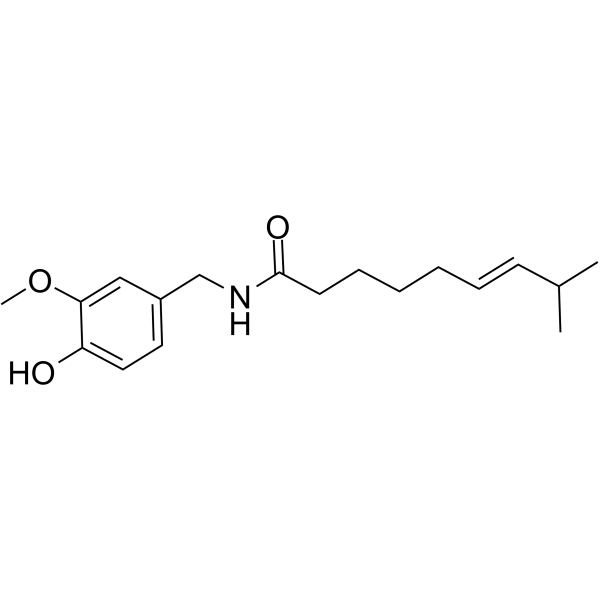Capsaicin (Synonyms: 辣椒素; (E)-Capsaicin) 纯度: 99.85%
Capsaicin ((E)-Capsaicin) 是辣椒中的活性成分,是一种 TRPV1 激动剂。Capsaicin 具有减轻疼痛、抗氧化、抗炎、神经保护和抗癌作用。

Capsaicin Chemical Structure
CAS No. : 404-86-4
| 规格 | 价格 | 是否有货 | 数量 |
|---|---|---|---|
| Free Sample (0.1-0.5 mg) | Apply now | ||
| 10 mM * 1 mL in DMSO | ¥990 | In-stock | |
| 50 mg | ¥900 | In-stock | |
| 100 mg | ¥1530 | In-stock | |
| 200 mg | 询价 | ||
| 500 mg | 询价 |
* Please select Quantity before adding items.
Capsaicin 相关产品
•相关化合物库:
- Natural Product Library Plus
- Drug Repurposing Compound Library Plus
- FDA-Approved Drug Library Plus
- FDA-Approved Drug Library Mini
- Bioactive Compound Library Plus
- Apoptosis Compound Library
- Membrane Transporter/Ion Channel Compound Library
- Metabolism/Protease Compound Library
- Neuronal Signaling Compound Library
- Natural Product Library
- FDA-Approved Drug Library
- Anti-Cancer Compound Library
- Autophagy Compound Library
- Drug Repurposing Compound Library
- Lipid Compound Library
- Anti-COVID-19 Compound Library
- NMPA-Approved Drug Library
- Medicine Food Homology Compound Library
- Phenols Library
- Orally Active Compound Library
- Traditional Chinese Medicine Monomer Library
- FDA Approved & Pharmacopeial Drug Library
- Neuroprotective Compound Library
- Alkaloids Library
- Food Additive Library
- Food-Sourced Compound Library
- Mechanoreceptors Compound Library
- Rare Diseases Drug Library
| 生物活性 |
Capsaicin ((E)-Capsaicin), an active component of chili peppers, is a TRPV1 agonist. Capsaicin has pain relief, antioxidant, anti-inflammatory, neuroprotection and anti-cancer effects[1][2]. |
IC50 & Target |
EC50: 290 nM (hTRPV1, in HEK293 cell)[1] |
||||||||||||||||||||||
|---|---|---|---|---|---|---|---|---|---|---|---|---|---|---|---|---|---|---|---|---|---|---|---|---|---|
| 体外研究 (In Vitro) |
Capsaicin (50-300 µM; 24-72 hours) shows an augmented decrease in cell growth in a dose- and time-dependent manner. The observed IC50 value is around 150 µM[2]. MCE has not independently confirmed the accuracy of these methods. They are for reference only. Cell Viability Assay[2]
Apoptosis Analysis[2]
Western Blot Analysis[2]
|
||||||||||||||||||||||||
| 体内研究 (In Vivo) |
Capsaicin suppresses the development of lung carcinoma by amending the protein expressions of apoptotic regulators p53, Bcl-2, Bax and caspase-3[2]. MCE has not independently confirmed the accuracy of these methods. They are for reference only.
|
||||||||||||||||||||||||
| Clinical Trial |
|
||||||||||||||||||||||||
| 分子量 |
305.41 |
||||||||||||||||||||||||
| Formula |
C18H27NO3 |
||||||||||||||||||||||||
| CAS 号 |
404-86-4 |
||||||||||||||||||||||||
| 中文名称 |
辣椒素;辣椒碱 |
||||||||||||||||||||||||
| 运输条件 |
Room temperature in continental US; may vary elsewhere. |
||||||||||||||||||||||||
| 储存方式 |
4°C, protect from light *In solvent : -80°C, 6 months; -20°C, 1 month (protect from light) |
||||||||||||||||||||||||
| 溶解性数据 |
In Vitro:
Ethanol : 200 mg/mL (654.86 mM; Need ultrasonic) DMSO : 100 mg/mL (327.43 mM; Need ultrasonic) 配制储备液
*
请根据产品在不同溶剂中的溶解度选择合适的溶剂配制储备液;一旦配成溶液,请分装保存,避免反复冻融造成的产品失效。 In Vivo:
请根据您的实验动物和给药方式选择适当的溶解方案。以下溶解方案都请先按照 In Vitro 方式配制澄清的储备液,再依次添加助溶剂: ——为保证实验结果的可靠性,澄清的储备液可以根据储存条件,适当保存;体内实验的工作液,建议您现用现配,当天使用; 以下溶剂前显示的百
|
||||||||||||||||||||||||
| 参考文献 |
|
